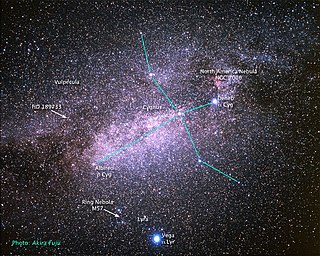
CoRoT was a space telescope mission which operated from 2006 to 2013. The mission's two objectives were to search for extrasolar planets with short orbital periods, particularly those of large terrestrial size, and to perform asteroseismology by measuring solar-like oscillations in stars. The mission was led by the French Space Agency (CNES) in conjunction with the European Space Agency (ESA) and other international partners.

HD 209458 is a star with an orbiting exoplanet in the constellation Pegasus. It has an apparent visual magnitude of 7.65 and an absolute magnitude of 4.28. Because it is located at a distance of 157 light-years from the Sun as measured via parallax, it is not visible to the unaided eye. With good binoculars or a small telescope it should be easily detectable. The system is drifting closer with a heliocentric radial velocity of −14.8 km/s.

HD 189733, also catalogued as V452 Vulpeculae, is a binary star system 64.5 light-years away in the constellation of Vulpecula. The primary star is suspected to be an orange dwarf star, while the secondary star is a red dwarf star. Given that this system has the same visual magnitude as HD 209458, it promises much for the study of close transiting extrasolar planets. The star can be found with binoculars 0.3 degrees east of the Dumbbell Nebula (M27).

HD 189733 b is an exoplanet in the constellation of Vulpecula approximately 64.5 light-years away from the Solar System. Astronomers in France discovered the planet orbiting the star HD 189733 on October 5, 2005, by observing its transit across the star's face. With a mass 11.2% higher than that of Jupiter and a radius 11.4% greater, HD 189733 b orbits its host star once every 2.2 days at an orbital speed of 152.0 kilometers per second, making it a hot Jupiter with poor prospects for extraterrestrial life.
HD 114762 b is a small red dwarf star, in the HD 114762 system, formerly thought to be a massive gaseous extrasolar planet, approximately 126 light-years (38.6 pc) away in the constellation of Coma Berenices. This optically undetected companion to the late F-type main-sequence star HD 114762 was discovered in 1989 by Latham, et al., and confirmed in an October 1991 paper by Cochran, et al. It was thought to be the first discovered exoplanet
HD 196050 is a triple star system located in the southern constellation of Pavo. This system has an apparent magnitude of 7.50 and the absolute magnitude is 4.01. It is located at a distance of 165 light-years from the Sun based on parallax, and is drifting further away with a radial velocity of +61 km/s. It is also called by the Hipparcos designation HIP 101806.
WASP-6, also officially named Márohu, is a type-G yellow dwarf star located about 651 light-years away in the Aquarius constellation. Dim at magnitude 12, it is visible through a moderate sized amateur telescope. The star is about 80% of the size and mass of the Sun and it is a little cooler. Starspots in the WASP-6 system helped to refine the measurements of the mass and the radius of the planet WASP-6b.

WASP-8 is a binary star system 294 light-years away. The star system is much younger than the Sun at 300 million to 1.2 billion years age, and is heavily enriched in heavy elements, having nearly twice the concentration of iron compared to the Sun.

Leonhard Euler Telescope, or the Swiss EULER Telescope, is a national, fully automatic 1.2-metre (47 in) reflecting telescope, built and operated by the Geneva Observatory. It is located at an altitude of 2,375 m (7,792 ft) at ESO's La Silla Observatory site in the Chilean Norte Chico region, about 460 kilometers north of Santiago de Chile. The telescope, which saw its first light on 12 April 1998, is named after Swiss mathematician Leonhard Paul Euler.
WASP-33b is an extrasolar planet orbiting the star HD 15082. It was the first planet discovered to orbit a Delta Scuti variable star. With a semimajor axis of 0.026 AU and a mass likely greater than Jupiter's, it belongs to the hot Jupiter class of planets.

WASP-121b, formally named Tylos, is an exoplanet orbiting the star WASP-121. WASP-121b is the first exoplanet found to contain water in an extrasolar planetary stratosphere. WASP-121b is in the constellation Puppis, and is about 858 light-years from Earth.
HD 146389, is a star with a yellow-white hue in the northern constellation of Hercules. The star was given the formal name Irena by the International Astronomical Union in January 2020. It is invisible to the naked eye with an apparent visual magnitude of 9.4 The star is located at a distance of approximately 446 light years from the Sun based on parallax, but is drifting closer with a radial velocity of −9 km/s. The star is known to host one exoplanet, designated WASP-38b or formally named 'Iztok'.







